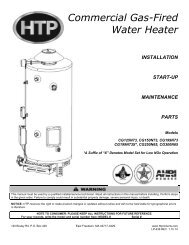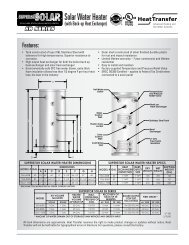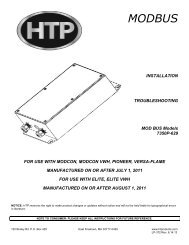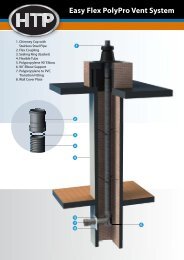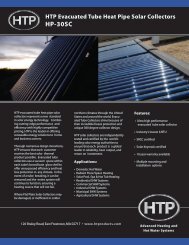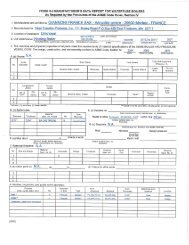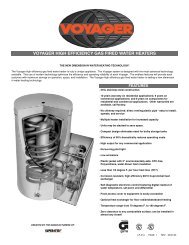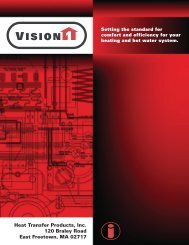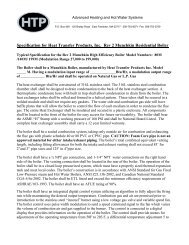MC Series Gas-Fired Circulating Heater - Heat Transfer Products, Inc
MC Series Gas-Fired Circulating Heater - Heat Transfer Products, Inc
MC Series Gas-Fired Circulating Heater - Heat Transfer Products, Inc
Create successful ePaper yourself
Turn your PDF publications into a flip-book with our unique Google optimized e-Paper software.
8<br />
Water pH between 6.0 and 8.0<br />
o Maintain water pH between 6.0 and 8.0. Check with litmus paper or have it chemically analyzed by water treatment<br />
company.<br />
o If the pH differs from above, consult local water treatment company for treatment needed.<br />
Hardness less than 7 grains<br />
o Consult local water treatment companies for unusually hard water areas (above 7 grains hardness).<br />
Chlorine concentration less than 100 ppm<br />
o Using chlorinated fresh water should be acceptable as levels are typically less than 5 ppm.<br />
o Do not connect the heater to directly heat swimming pool or spa water.<br />
o Do not fill heater or operate with water containing chlorine in excess of 100 ppm.<br />
*NOTE: It is recommended to clean heat exchanger at least once a year to prevent lime scale buildup. To clean the heat<br />
exchanger, follow the maintenance procedure in Part 15, Section B of this manual.<br />
Hardness: 7 grains<br />
Chloride levels: 100 ppm<br />
pH levels: 6-8<br />
TDS: 2000 ppm<br />
Sodium: 20 mGL<br />
G. WINTERIZING<br />
NEVER use any toxic chemical, including automotive, standard glycol antifreeze, or ethylene glycol made for hydronic (non-potable)<br />
systems. These chemicals can attack gaskets and seals in heaters, are poisonous if consumed, and can cause injury or death.<br />
Consider piping and installation when determining heater location.<br />
To winterize the heater, drain the entire system. Then apply air pressure to the drain valve and allow air and water to escape from the<br />
purge valve (see piping instructions).<br />
Once you have evacuated as much water as possible, pump non-toxic, NSF food grade propylene glycol, FDA rated as GRAS<br />
(Generally Recognized As Safe), into the system. Consult the glycol manufacturer for specific instructions on concentration percentage<br />
as well as freeze and burst protection methods. Check the volume and concentration of antifreeze to assure protection is adequate to<br />
protect the entire system from freezing. When pumping, allow air and remaining water to escape from purge valve. When the stream<br />
coming out of the purge valve matches the color of the non-toxic glycol, the system is adequately filled.<br />
Finally, it is recommended to start the circulation pump and allow the system to circulate for at 30 minutes to completely blend any<br />
trapped water that might be in the system with the glycol.<br />
PART 2 – BEFORE YOU START<br />
A. WHAT’S IN THE BOX<br />
Also included with the heater:<br />
Temperature and Pressure Relief Valve<br />
Pressure and Temperature Gauge<br />
Intake PVC Tee with Screens<br />
Exhaust PVC Coupling with Screens<br />
Plastic hose and Instructions for Purging <strong>Heat</strong> Exchanger<br />
Installation Manual<br />
Warranty<br />
B. HOW THE HEATER OPERATES<br />
Modulation Condensing Technology is an intelligent system that delivers highly efficient water heating, while maximizing efficiency<br />
by measuring the data parameters of your system.<br />
Stainless Steel <strong>Heat</strong> Exchanger<br />
The highly efficient and durable stainless steel heat exchanger is designed to extract the last bit of energy from flue gas before it is<br />
exhausted.<br />
LP-171 Rev. 10.2.13



